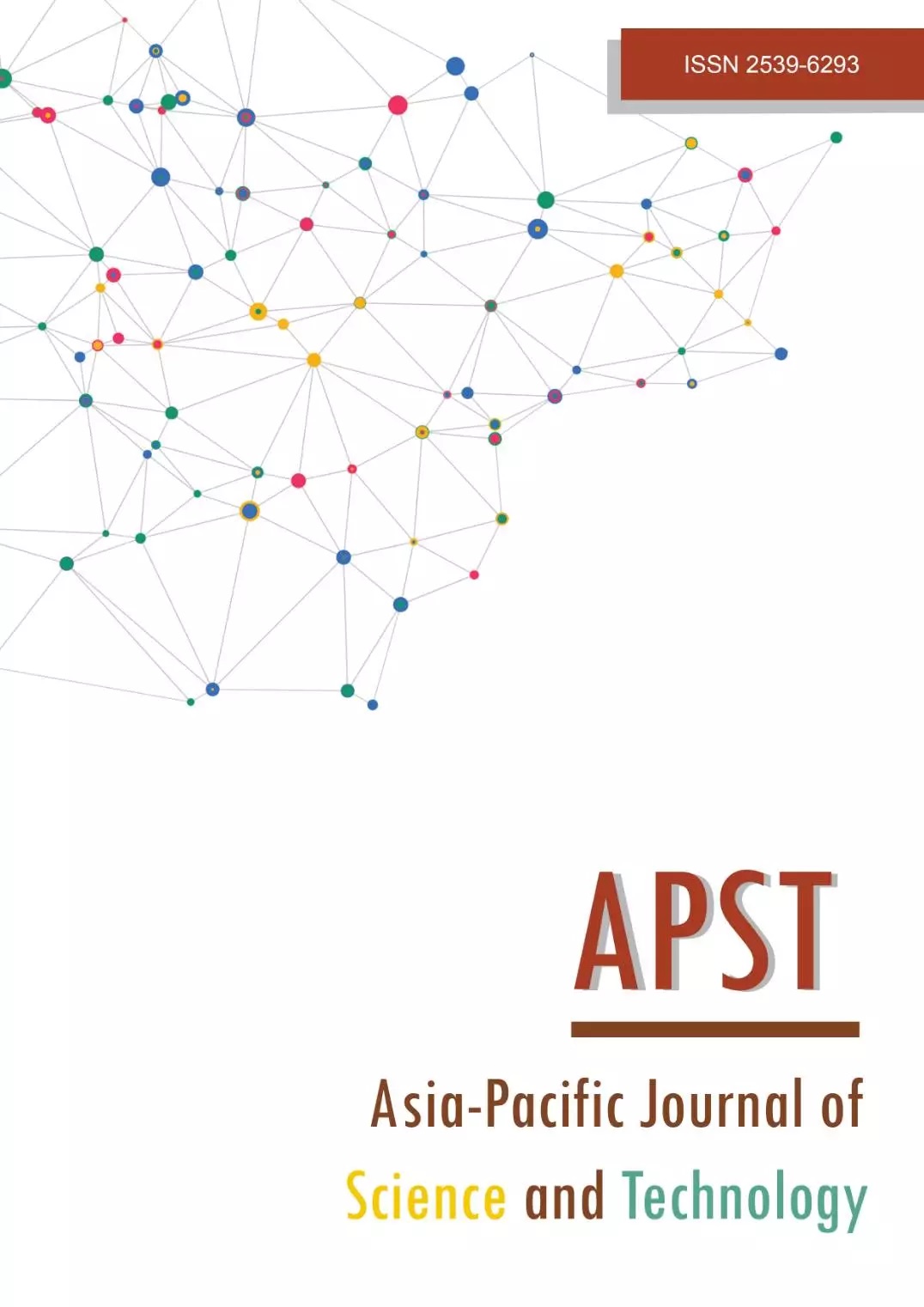A preliminary assessment of heavy metal (Pb, Cd, and As) contamination in the leaves and cultivation area of Mitragyna speciosa (Korth.) originating from Thailand
Main Article Content
Abstract
Kratom (Mitragyna speciosa (Korth.)) is a plant with various therapeutic applications, treating such ailments as chronic pain and diabetes. Its primary alkaloid, mitragynine, exhibits opioid-like effects without respiratory depression; thus, kratom may be used to treat opioid addiction. However, heavy metal contamination can compromise kratom’s safety and quality. This study examined heavy metal contamination (from arsenic [As], cadmium [Cd], and lead [Pb]) in Thai kratom cultivation areas and dried leaves using inductively coupled plasma mass spectrometry (ICP-MS). Mitragynine concentrations in green Thai kratom (GTK) and red Thai kratom (RTK) were also quantified. The analysis revealed that the As, Pb, and Cr levels in kratom leaves were below the safety thresholds, but soil samples showed significantly high As contamination (177.94±1.30 mg/kg). Mitragynine concentrations were higher in GTK (52.68 mg/g (Ethanol extract)) compared with RTK (39.77 mg/g (Ethanol extract)). The findings provide essential information on heavy metal contamination and mitragynine content in kratom leaves and cultivation areas. While safe levels of heavy metals were found in leaves, elevated As concentrations in soil samples raise concerns about long-term contamination risks. The mitragynine content variability between GTK and RTK warrants further investigation to understand its pharmacological and therapeutic implications. This study emphasizes the need for continued kratom research to ensure kratom’s safe and effective use in traditional and modern medicine.
Article Details

This work is licensed under a Creative Commons Attribution-NonCommercial-NoDerivatives 4.0 International License.
References
Yusoff NHM, Mansor SM, Müller CP, Hassan Z. Opioid receptors mediate the acquisition, but not the expression of mitragynine-induced conditioned place preference in rats. Behav Brain Res. 2017;332:1-6.
Hiranita T, Obeng S, Sharma A, Wilkerson JL, McCurdy CR, McMahon LR. In vitro and in vivo pharmacology of kratom. Adv Pharmacol. 2022;93:35-76.
Meepong R, Sooksawate T. Mitragynine reduced morphine-induced conditioned place preference and withdrawal in rodents. Thai J Pharm Sci. 2019;43:21-29.
Office of the Narcotics Control Board Ministry of Justice. Thailand narcotics control annual report 2020. [cited 4 Apr 2023]. Available from: https://www.oncb.go.th/EN_ONCE/Documents/Thailand%20Narcotic
s%20Control%20Annual%20Report%202020.pdf.
La-up A, Saengow U, Aramrattana A. High serum high-density lipoprotein and low serum triglycerides in kratom users: A study of kratom users in Thailand. Heliyon. 2021;7(4):1-8.
Mukherjee PK. Phytomedicines: Back to the future. J Nat Prod. 1999;62(11):1589–1592.
Jomova K, Makova M, Alomar SY, Alwasel SH, Nepovimova E, Kuca K, et al. Essential metals in health and disease. Chem Biol Interact. 2022;367:1-28.
Briffa J, Sinagra E, Blundell R. Heavy metal pollution in the environment and their toxicological effects on humans. Heliyon. 2020;6(9):1-26.
Chen YG, He XLS, Huang JH, Luo R, Ge HZ, Wołowicz A, et al. Impacts of heavy metals and medicinal crops on ecological systems, environmental pollution, cultivation, and production processes in China. Ecotoxicol Environ Saf. 2021;219:1-17.
Yimthiang S, Pouyfung P, Khamphaya T, Kuraeiad S, Wongrith P, Vesey DA, et al. Effects of environmental exposure to cadmium and lead on the risks of diabetes and kidney dysfunction. Int J Environ Res Public Health. 2022;19(4):1-12.
Rai PK, Lee SS, Zhang M, Tsang YF, Kim KH. Heavy metals in food crops: Health risks, fate, mechanisms, and management. Environ Int. 2019;125:365-385.
Ting A, Chow Y, Tan W. Microbial and heavy metal contamination in commonly consumed traditional Chinese herbal medicines. J Tradit Chin Med. 2013;33:119-124.
Luo L, Wang B, Jiang J, Fitzgerald M, Huang Q, Yu Z, et al. Heavy metal contaminations in herbal medicines: determination, comprehensive risk assessments, and solutions. Front Pharmacol. 2021;11:2016:1-14.
Gunturu KS, Nagarajan P, McPhedran P, Goodman TR, Hodsdon ME, Strout MP. Ayurvedic herbal medicine and lead poisoning. J Hematol Oncol. 2011;4:1-6.
Brevik EC, Slaughter L, Singh BR, Steffan JJ, Collier D, Barnhart P, et al. Soil and human health: current status and future needs. Air Soil Water Res. 2020;13:1-23.
Saengow U, Vijitpongjinda S, Yimthiang S, Wattanapisit A, Thaicharoen S. Urinary arsenic concentration among residents of an arsenic-endemic area in southern Thailand and its related factors: three decades after mitigation attempts. Groundw Sustain Dev. 2022;16:100725.
Sripaoraya K, Siriwong W, Pavittranon S, Chapman RS. Environmental arsenic exposure and risk of diabetes type 2 in Ron Phibun subdistrict, Nakhon Si Thammarat Province, Thailand: unmatched and matched case and control studies. Risk Manag Healthc Policy. 2017;10:41-48.
Kafle A, Timilsina A, Gautam A, Adhikari K, Bhattarai A, Aryal N. Phytoremediation: Mechanisms, plant selection and enhancement by natural and synthetic agents. Environ Adv. 2022;8:1-18.
Gao X, Rodrigues SM, Spielman-Sun E, Lopes S, Rodrigues S, Zhang Y, et al. Effect of soil organic matter, soil pH, and moisture content on solubility and dissolution rate of CuO NPs in soil. Environ Sci Technol. 2019;53:4959-4967.
Hassan Z, Muzaimi M, Navaratnam V, Yusoff NHM, Suhaimi FW, Vadivelu R, et al. From kratom to mitragynine and its derivatives: Physiological and behavioural effects related to use, abuse, and addiction. Neurosci Biobehav Rev. 2013;37:138-151.
Kumarnsit E, Keawpradub N, Nuankaew W. Effect of Mitragyna speciosa aqueous extract on ethanol withdrawal symptoms in mice. Fitoterapia. 2007;78:182-185.
Zhang M, Sharma A, León F, Avery B, Kjelgren R, McCurdy CR, et al. Effects of nutrient fertility on growth and alkaloidal content in Mitragyna speciosa (Kratom). Front Plant Sci. 2020;11:1-12.
Zhang M, Sharma A, León F, Avery B, Kjelgren R, McCurdy CR, et al. Plant growth and phytoactive alkaloid synthesis in kratom [Mitragyna speciosa (Korth.)] in response to varying radiance. PLoS One. 2022;17:1-16.
Leksungnoen N, Andriyas T, Ngernsaengsaruay C, Uthairatsamee S, Racharak P, Sonjaroon W, et al. Variations in mitragynine content in the naturally growing kratom (Mitragyna speciosa) population of Thailand. Front Plant Sci. 2022;13:01-15.
Prozialeck W, Fowler A, Edwards J. Public health implications and possible sources of lead (Pb) as a contaminant of poorly regulated kratom products in the United States. Toxics. 2022;10(7):1-11.


